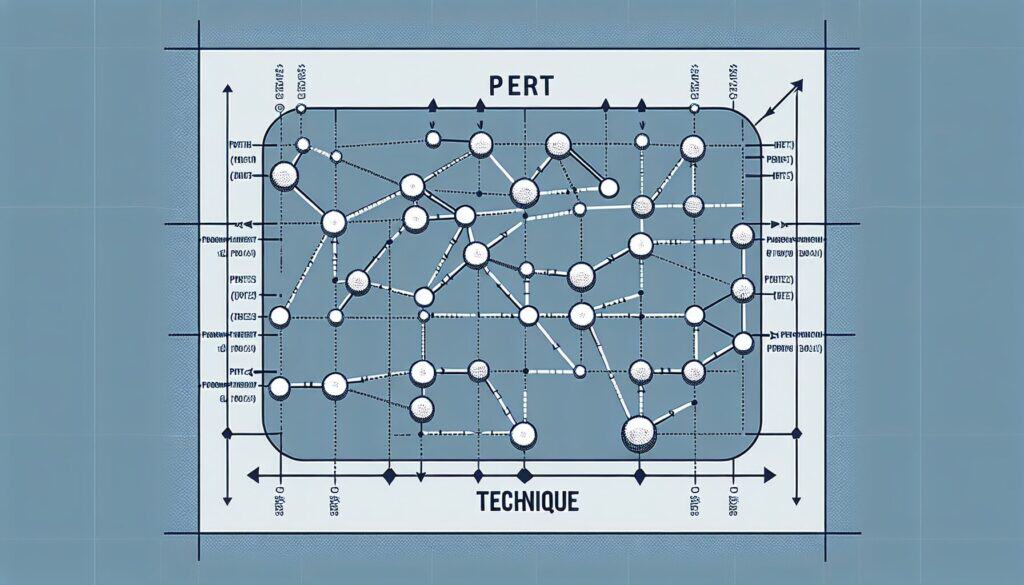PERT (Program Evaluation and Review Technique): a project management technique used for planning and controlling projects with uncertain task durations, by using probabilistic time estimates (optimistic, pessimistic, and most likely) to determine the expected duration of activities and the project.
- Méthodologies : Lean Sigma, Fabrication
PERT Diagram

PERT Diagram
- Méthodologie Agile, Amélioration continue, Optimisation des processus, Program Evaluation and Review Technique (PERT), Gestion de projet, Gestion de la qualité, Recherche et développement, Gestion des risques
Objectif :
Comment il est utilisé :
- For each task, three time estimates are made: optimistic (to), pessimistic (tp), and most likely (tm). These are used to calculate an expected duration (te = (to + 4tm + tp)/6). These expected durations are then used to determine the critical path and project duration, often incorporating probabilities.
Avantages
- Accounts for uncertainty in task durations, providing a more realistic schedule; Helps identify critical tasks and potential project risks related to time; Allows for calculating the probability of meeting project deadlines.
Inconvénients
- Requires more effort to estimate three durations for each task; The probabilistic calculations can be complex; Relies on subjective estimates, which may be biased; The underlying beta distribution assumption may not always hold true.
Catégories :
- Gestion de projet, Gestion des risques
Idéal pour :
- Planning and managing complex projects where activity durations are uncertain, particularly for R&D or novel projects.
The PERT (Program Evaluation and Review Technique) Diagram methodology is widely applied in various industries such as aerospace, software development, construction, and pharmaceuticals, especially during the planning and execution phases of projects that involve a high degree of uncertainty. In R&D projects or innovative product development, where activities might be novel and time estimates less predictable, PERT’s focus on evaluating optimistic, pessimistic, and most likely scenarios allows teams to create a more accurate picture of project timelines. This methodology is particularly useful during the initial stages of a project when decisions regarding resource allocation and task prioritization are made, helping project managers assess potential bottlenecks and allocate efforts accordingly. The involvement of stakeholders throughout the project, including engineers, designers, and project managers, ensures that diverse perspectives inform the estimations, leading to more reliable projections. PERT also facilitates scenario analysis, enabling teams to gauge the impact of various factors on the expected project duration and to assess the probability of completing tasks on time. Regularly updating the PERT diagram can help teams adjust their plans based on real-time data, which is important as unforeseen challenges arise. In this context, the methodology not only aids in time management but also encourages collaboration and communication among team members, fostering a project environment that can adapt to changing requirements.
Principales étapes de cette méthodologie
- Define the project tasks and milestones.
- Estimate three time durations for each task: optimistic (to), most likely (tm), and pessimistic (tp).
- Calculate the expected duration (te) for each task using the formula te = (to + 4tm + tp)/6.
- Create a PERT diagram illustrating the tasks, their dependencies, and expected durations.
- Identify the critical path by determining the longest path through the PERT diagram.
- Analyze the probabilities of completing the project by specific deadlines based on the critical path.
- Use the PERT diagram to monitor progress and adjust timelines as needed throughout the project.
Conseils de pro
- Regularly update time estimates based on project progress to refine predictions and adjust the PERT Diagram effectively.
- Integrate Monte Carlo simulation alongside the PERT analysis to quantify risks and variances in project timelines.
- Collaborate with cross-functional teams during planning to gather diverse inputs for each time estimate, enhancing accuracy.
Lire et comparer plusieurs méthodologies, nous recommandons le
> Référentiel méthodologique étendu <
ainsi que plus de 400 autres méthodologies.
Vos commentaires sur cette méthodologie ou des informations supplémentaires sont les bienvenus sur le site web de la Commission européenne. section des commentaires ci-dessous ↓ , ainsi que toute idée ou lien en rapport avec l'ingénierie.
Contexte historique
1949
1950
1950
1960
1960
1960
1960
1940
1950
1950
1958
1960
1960
1960
1960
(si la date est inconnue ou n'est pas pertinente, par exemple "mécanique des fluides", une estimation arrondie de son émergence notable est fournie)















Articles Similaires
Gestion des opérations de fabrication (MOM)
Système d'exécution de la fabrication (MES)
Plan de contrôle de la fabrication
Tests manuels
Tableaux d'évaluation des manutentions manuelles (MAC)
ManTRA (outil d'évaluation des risques liés aux tâches manuelles)